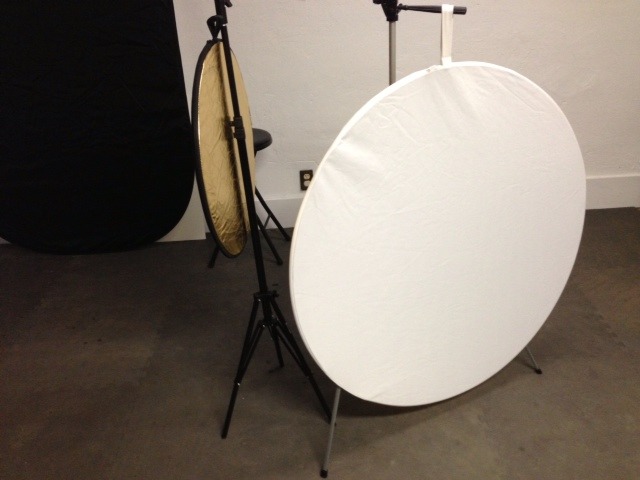 Sometimes just adding a reflector to your flash shooting arsenal is enough to give you that extra light you need for an image you can’t seem to get with just one light. This can save you from investing in another flash unit and remote trigger receiver. The reflector fills the need often when you are using one light and are getting deep shadows on the opposite side of your subject from where the light is coming from. Perhaps there is no wall to reflect light off of and you don’t have another flash to use for fill, as a second light is often called. Your one light is referred to as your “key” light and if you are positioning it camera-right so it is illuminating your subject’s left side of the face, then it will naturally leave a shadow on your subject’s right side of the face and hair.
However, if you have someone hold (or can otherwise secure it by propping it against something, etc.) a reasonably sized reflector so that it bounces light from your key light back onto the right side of your subject’s face, this will often lighten up the shadows just enough. And the nice thing is you can start out with just a piece of white foam core board, as they can by highly reflective and are just a few dollars at your local craft store. Eventually, though, you will probably want to purchase a collapsible reflector and one that has several different coverings to change the color - and use - of the reflective surface. The typical one photographers purchase is a 5-in-1 reflector which comes in various sizes from 12” up to very large, circular reflector kits. 36” to 43” is the typical size bought for this purpose. The 5-in-1 name refers to the fact that the base frame usually has a translucent material on it so you can use it as a diffuser to block light and soften it. Then there is a 4-sided cover that fits over the frame and is secured with a zipper. When put on the frame, the two outside sides are usually white and silver, both reflective. Then, if you turn this “cover” inside out, the other two sides are often gold and a gold/silver mixture. You can use these four different reflective surfaces to get four different looks in your images.
Sometimes just adding a reflector to your flash shooting arsenal is enough to give you that extra light you need for an image you can’t seem to get with just one light. This can save you from investing in another flash unit and remote trigger receiver. The reflector fills the need often when you are using one light and are getting deep shadows on the opposite side of your subject from where the light is coming from. Perhaps there is no wall to reflect light off of and you don’t have another flash to use for fill, as a second light is often called. Your one light is referred to as your “key” light and if you are positioning it camera-right so it is illuminating your subject’s left side of the face, then it will naturally leave a shadow on your subject’s right side of the face and hair.
However, if you have someone hold (or can otherwise secure it by propping it against something, etc.) a reasonably sized reflector so that it bounces light from your key light back onto the right side of your subject’s face, this will often lighten up the shadows just enough. And the nice thing is you can start out with just a piece of white foam core board, as they can by highly reflective and are just a few dollars at your local craft store. Eventually, though, you will probably want to purchase a collapsible reflector and one that has several different coverings to change the color - and use - of the reflective surface. The typical one photographers purchase is a 5-in-1 reflector which comes in various sizes from 12” up to very large, circular reflector kits. 36” to 43” is the typical size bought for this purpose. The 5-in-1 name refers to the fact that the base frame usually has a translucent material on it so you can use it as a diffuser to block light and soften it. Then there is a 4-sided cover that fits over the frame and is secured with a zipper. When put on the frame, the two outside sides are usually white and silver, both reflective. Then, if you turn this “cover” inside out, the other two sides are often gold and a gold/silver mixture. You can use these four different reflective surfaces to get four different looks in your images.
 So, run out and grab yourself a piece of 20x30” white foam core board and practice using that to add reflected light to the shadow areas of your one-flash shots. If you are liking the different effects you can achieve, then investigate one of the 5-in-1 kits. You won’t be disappointed.
So, run out and grab yourself a piece of 20x30” white foam core board and practice using that to add reflected light to the shadow areas of your one-flash shots. If you are liking the different effects you can achieve, then investigate one of the 5-in-1 kits. You won’t be disappointed.
My "Mobile Flash: Using the Flash Stick" class starts in late July. Check out the description and plan to register online at http://www.infotor.com/photoclasses/plannedclasses.php. I am also available to do one-on-one tutoring or small group lessons designed to meet YOUR needs and what you want to learn in the area of photography, using flashes, or the use of Apple products and software. Give yourself the gift of learning: http://www.infotor.com/photoclasses! Check out my special tutoring bundle: http://www.infotor.com/photoclasses/tutoringbundle.php!